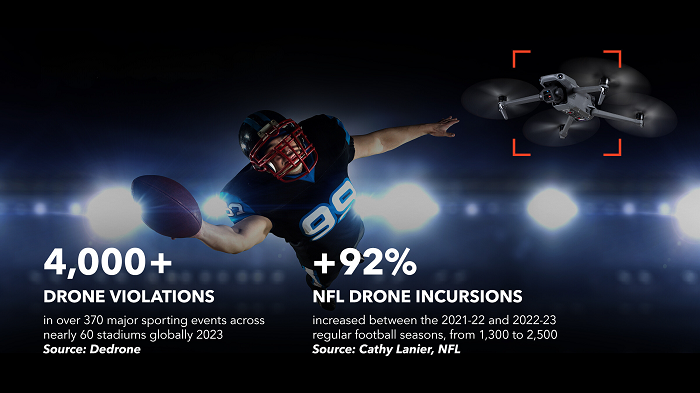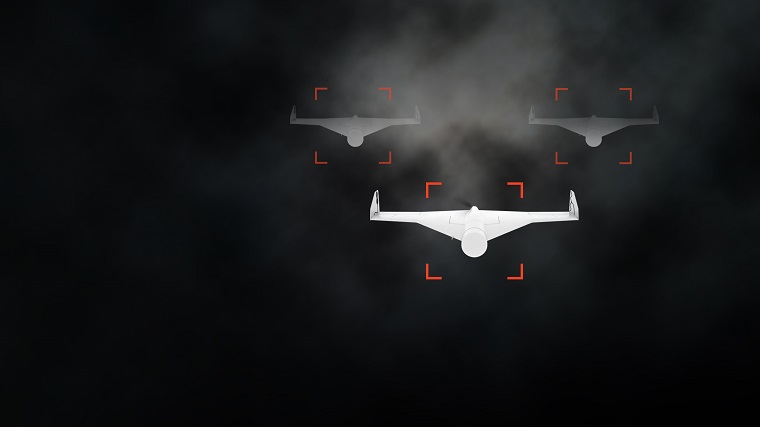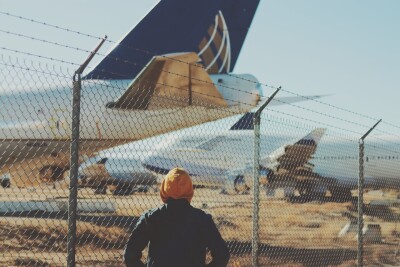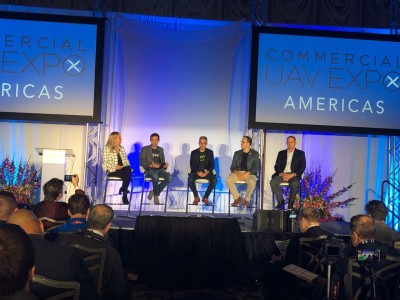For this year’s Super Bowl, the City of Las Vegas, NV was declared a no-drone zone. Threats posed by unauthorized or “rogue” drones were deemed so serious that the FAA restricted all flights between 2:30 until 8:30 p.m. on the day of the game for a 30-nautical-mile radius around Allegiant Stadium and up to 18,000 feet in altitude.
The FAA’s actions concerning the Super Bowl were not surprising because rogue drone threats are on the rise everywhere. Dedrone, a leader in smart airspace security, recently reported that more than 370 major sporting events at some 60 stadiums around the world experienced more than 4,000 illegal drone violations in 2023— “an increase of nearly 20% from 2022,” which “resulted in event delays, the apprehension of drone pilots, and an increased risk to public safety.”

To learn more about the threats presented by unauthorized drones and efforts to combat the dangers, Commercial UAV News spoke with Mary-Lou Smulders, Chief Marketing Officer at Dedrone. We discussed why the public should be concerned about unauthorized drones, advances in counter-uas systems, government regulations, and more.
Commercial UAV News: What are the real threats posed by unauthorized drones? What should the public be concerned about?
Smulders: From a safety perspective, people generally think of a drone falling from the sky and hitting someone. To some extent, that can happen, but the larger concern is posed by a payload-laden drone dropping something. It's very easy to modify a drone to do that. Someone could watch a five-minute YouTube video and buy a readily available drone via the Internet for $500 or less. So, the real concern is that they use that drone to drop something from the sky, and it could be something as nefarious as anthrax. But imagine if they dropped something like talcum powder. Panic would naturally ensue, and it would surely cause everyday people to get hurt.
Commercial UAV News: Are there other issues? What else can a rogue drone do?
Smulders: If you dig a little deeper, you’ll find there is a theft angle. Most people we catch flying where they should not be flying aren’t mal-intended—they’re looking for YouTube hits, for a cool photo. They fly over large-person venues—sporting events or concerts—and they steal content. People have paid for the rights to air that content, and if you're flying over it, capturing video or images and putting it somewhere, then, in a sense, you're stealing their product. The vast majority feign to be careless or clueless, but in fact, they're out there for the shots.
Commercial UAV News: Describe Dedrone’s counter-uas approach. What makes you different?
Smulders: We have the largest and most flexible solution. It involves tracking, locating, identifying, and, when we're allowed, mitigation. We handle the full spectrum of the incident from beginning to end. We detect the drone and the pilot. We identify them as friend or foe, determine what kind of drone they are and what payload. There’s also mitigation, which could involve bringing the drone down (when it’s allowed) or going to talk to the pilot.
Commercial UAV News: Talk about the technology behind these systems. How do you approach detection, tracking, and data analysis?

Smulders: Dedrone can take any input via radio frequency signal, by radar for longer range detections, and, most importantly, in a lot of these venues, with camera confirmation and payload interrogation. We actually don't care what RF sensor you use, what radar you use, what camera you use. We will ingest any of those sensor inputs. I can confidently and categorically say that we have more installs than anybody else. We're the only ones that publish our numbers. We have over 810 locations protected. And we have more case studies across every industry than anyone else. Also, we have pre-installed our hardware in over 50 cities in the US. And just like any other app you have on your phone or on your computer, you log in and you're immediately given that data for your region. That is especially convenient to people like private security professionals who might be at a stadium or arena, because there are no hardware installation requirements.
Commercial UAV News: How do you balance detection and mitigation systems for unauthorized vehicles with a system that allows authorized drones to fly?
Smulders: I think “authorized” and “unauthorized” is the right way to think about it. Our company mission is to protect from the threat of malicious drones while enabling the good drones to fly.
On the protection side, we offer a number of solutions that all use DedroneTracker.AI, our command and control platform, which provides both tracking and location of the drone and its pilot as well as whitelisting specific drones that have been authorized to fly in the restricted airspace. In practice, this means we can identify drones that are flying for security reasons, doing surveillance, or are authorized in other ways. For example, if CBS has bought the rights to air a particular event, we can whitelist their drones in the software.
When it comes to enabling good drones to fly, we have a solution called DedroneBeyond that is focused on enabling drone-as-first-responder programs or “DFR” beyond the visual line of the pilot’s sight without visual observers being necessary. This means first responders and law enforcement can deploy a drone before someone arrives on the scene for key situational awareness.
Commercial UAV News: Can whitelisting help with other use cases, not just stadium security?
Smulders: Yes. Whitelisting is important around critical infrastructure, where drones might be used to inspect hard-to-reach places. In correctional facilities, for example, we are seeing forward-thinking institutions use good drones for perimeter protection. Law enforcement can also whitelist any drones they are using for DFR programs.
Commercial UAV News: Going forward, what needs to happen for us to effectively handle issues around rogue drones while allowing for the expanded use of authorized drones?
Smulders: Today, state and local law enforcement agencies have to have the FBI come in and provide that mitigation because they're one of only four agencies in the US that can do it. They were only able to fulfill 6% of those requests over the last five years. The FBI can't cover them all. To help, there's a formal letter signed by MLB, the NCAA, the NFL, and NASCAR, begging the US government to please expand authorities around mitigation, and there are proposals on the table from both the House and the Senate to deal with the problem. It’s a hotly contested issue, but we’re taking steps in the right direction.















Comments